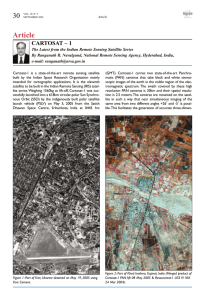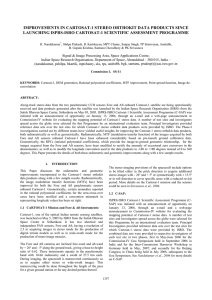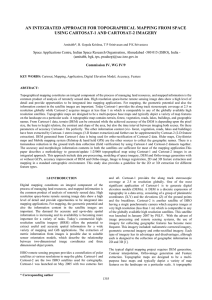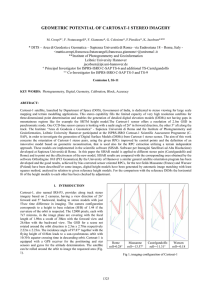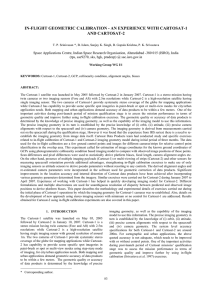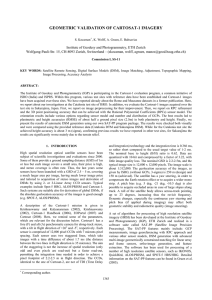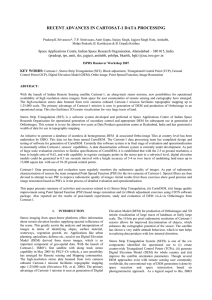GEOMETRIC QUALITY ASSESSMENT OF CARTOSAT-1 DATA PRODUCTS
advertisement
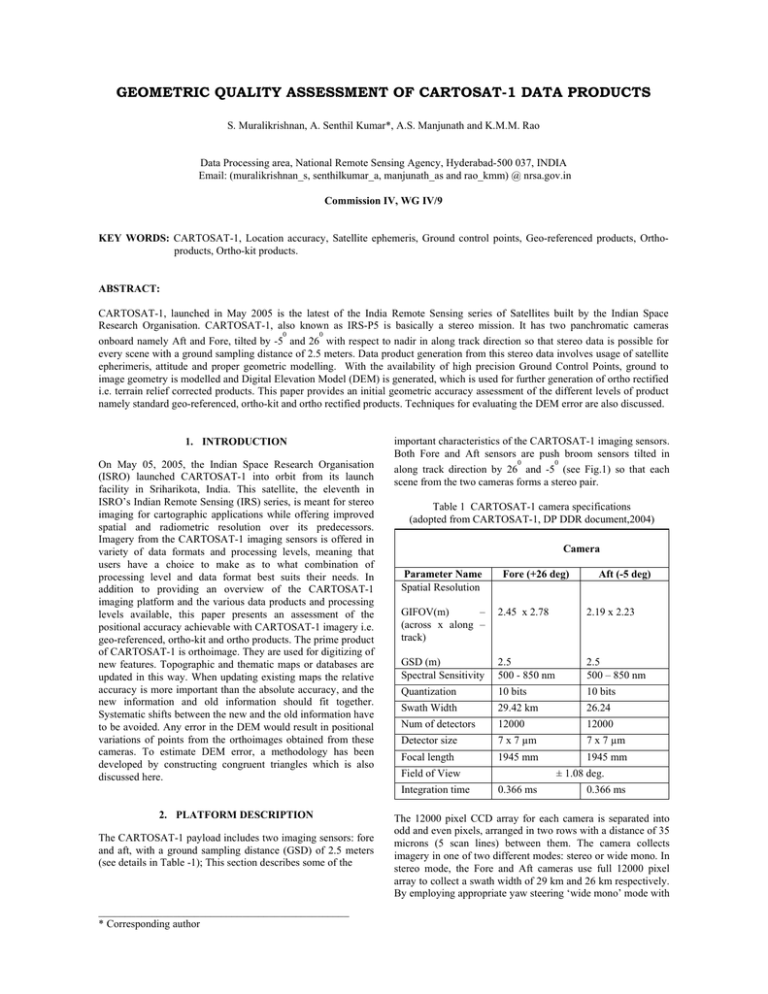
GEOMETRIC QUALITY ASSESSMENT OF CARTOSAT-1 DATA PRODUCTS S. Muralikrishnan, A. Senthil Kumar*, A.S. Manjunath and K.M.M. Rao Data Processing area, National Remote Sensing Agency, Hyderabad-500 037, INDIA Email: (muralikrishnan_s, senthilkumar_a, manjunath_as and rao_kmm) @ nrsa.gov.in Commission IV, WG IV/9 KEY WORDS: CARTOSAT-1, Location accuracy, Satellite ephemeris, Ground control points, Geo-referenced products, Orthoproducts, Ortho-kit products. ABSTRACT: CARTOSAT-1, launched in May 2005 is the latest of the India Remote Sensing series of Satellites built by the Indian Space Research Organisation. CARTOSAT-1, also known as IRS-P5 is basically a stereo mission. It has two panchromatic cameras 0 0 onboard namely Aft and Fore, tilted by -5 and 26 with respect to nadir in along track direction so that stereo data is possible for every scene with a ground sampling distance of 2.5 meters. Data product generation from this stereo data involves usage of satellite epherimeris, attitude and proper geometric modelling. With the availability of high precision Ground Control Points, ground to image geometry is modelled and Digital Elevation Model (DEM) is generated, which is used for further generation of ortho rectified i.e. terrain relief corrected products. This paper provides an initial geometric accuracy assessment of the different levels of product namely standard geo-referenced, ortho-kit and ortho rectified products. Techniques for evaluating the DEM error are also discussed. 1. INTRODUCTION On May 05, 2005, the Indian Space Research Organisation (ISRO) launched CARTOSAT-1 into orbit from its launch facility in Sriharikota, India. This satellite, the eleventh in ISRO’s Indian Remote Sensing (IRS) series, is meant for stereo imaging for cartographic applications while offering improved spatial and radiometric resolution over its predecessors. Imagery from the CARTOSAT-1 imaging sensors is offered in variety of data formats and processing levels, meaning that users have a choice to make as to what combination of processing level and data format best suits their needs. In addition to providing an overview of the CARTOSAT-1 imaging platform and the various data products and processing levels available, this paper presents an assessment of the positional accuracy achievable with CARTOSAT-1 imagery i.e. geo-referenced, ortho-kit and ortho products. The prime product of CARTOSAT-1 is orthoimage. They are used for digitizing of new features. Topographic and thematic maps or databases are updated in this way. When updating existing maps the relative accuracy is more important than the absolute accuracy, and the new information and old information should fit together. Systematic shifts between the new and the old information have to be avoided. Any error in the DEM would result in positional variations of points from the orthoimages obtained from these cameras. To estimate DEM error, a methodology has been developed by constructing congruent triangles which is also discussed here. important characteristics of the CARTOSAT-1 imaging sensors. Both Fore and Aft sensors are push broom sensors tilted in 0 0 along track direction by 26 and -5 (see Fig.1) so that each scene from the two cameras forms a stereo pair. Table 1 CARTOSAT-1 camera specifications (adopted from CARTOSAT-1, DP DDR document,2004) Camera Parameter Name Spatial Resolution The CARTOSAT-1 payload includes two imaging sensors: fore and aft, with a ground sampling distance (GSD) of 2.5 meters (see details in Table -1); This section describes some of the _______________________________________________ * Corresponding author Aft (-5 deg) GIFOV(m) – (across x along – track) 2.45 x 2.78 2.19 x 2.23 GSD (m) Spectral Sensitivity 2.5 500 - 850 nm 2.5 500 – 850 nm Quantization 10 bits 10 bits Swath Width 29.42 km 26.24 Num of detectors 12000 12000 Detector size 7 x 7 µm 7 x 7 µm Focal length 1945 mm 1945 mm Field of View Integration time 2. PLATFORM DESCRIPTION Fore (+26 deg) ± 1.08 deg. 0.366 ms 0.366 ms The 12000 pixel CCD array for each camera is separated into odd and even pixels, arranged in two rows with a distance of 35 microns (5 scan lines) between them. The camera collects imagery in one of two different modes: stereo or wide mono. In stereo mode, the Fore and Aft cameras use full 12000 pixel array to collect a swath width of 29 km and 26 km respectively. By employing appropriate yaw steering ‘wide mono’ mode with 55 km swath is also possible. As with IRS-1C and IRS-1D, the camera has cross-track steering capability of ±26º from nadir, Aft Fore Figure 1. CARTOSAT-1 stereo imaging allowing the collection of cross-track stereo images or simply more frequent coverage of a given area of interest. 3. DATA PRODUCTS A variety of different processing levels and data formats are available for CARTOSAT-1 imagery, and users must choose the appropriate combination to suit their needs. All the data products are available in GeoTiff format. GeoTIFF format is currently available for all levels of processing. Nearly all photogrammetric and GIS software supports GeoTIFF, so it is a good choice for those who do not wish to perform any format conversion. The GeoTIFF product contains image file and metadata as a separate file. 3.1 PROCESSING LEVELS The four basic processing levels are Radiometric, standard Georeferenced, Ortho-kit and Ortho rectified. Of these four, the radiometric processing level along with rational polynomial coefficients (RPC) is offered in ortho-kit product not as separate standard product due to correction involved (discussed later) that make it difficult for most users to process the data. The radiometric corrections performed are detector normalization, stagger correction, failed detector correction, and line loss correction. These are described below (CARTOSAT-1, 2004). 3.1.1 Radiometric data: Detector normalization involves application of gain and bias values to account for the differing response of each detector, this removes the appearance of striping in the imagery and resultant image for which a single set of Digital Number (DN)-to-radiance conversion coefficients can be provided. Both the cameras have staggered even/odd detectors, as mentioned in the previous section. One dimensional cubic convolution resampling is employed to reconstruct the image as if the CCD array were composed of contiguous detectors. If a detector in the CCD array has failed or is not working properly, a value is interpolated from the two neighbouring working detectors. This correction is performed if no more than two adjacent detectors require interpolation. In case of data dropout during transfer from satellite to ground, whole lines may be missing from the image. If no more than three consecutive lines are missing, averaging or repetition of the preceding/following lines may be employed to fill in the gaps. 3.1.2 Geo-referenced data: Generation of standard or georeferenced (GR) data products from CARTOSAT-1 mission involves radiometric correction and geometric correction for orbit and attitude of the spacecraft with the help of satellite ephemeris and attitude sensor information. The Aft camera is the default data that is available to the users because of its near nadir mode. 3.1.3 Ortho-kit data: Ortho-kit product is supplied with rational polynomial coefficients (RPCs) providing a compact representation of the ground-to-image geometry, allowing end users to perform photogrammetric processing without requiring access to the physical camera model. Photogrammetric tasks such as block adjustment, 3D feature extraction and rectification are accomplished by the use of camera model expressing the relationship between object space (points on the ground) and image space (pixels in the image). For CARTOSAT-1 ortho-kit images, this camera model is provided in the form of third order rational polynomial with twenty coefficients expressing the ground-to-image geometry. Numerical values for the polynomial coefficients are provided as part of the image metadata. 3.1.4 Ortho rectified data: Ortho rectified products are generated by using Ground Control Points (GCP) network of points collected across the country following stereo-strip triangulation algorithm. In Ortho image generation, Digital elevation Model (DEM) of the area is computed internally and used to compensate for relief displacement of the terrain. 4. METHODOLOGY The assessment of data is done using two sources of references i.e. IRS LISS-III geocoded reference image library, whose accuracy is within 50 meters and GCPs with better than 50 cm accuracy. Large number of features identifiable both in georeferenced data and the LISS-III reference data were collected and the location errors were computed in terms of RMS error and radial error. Further attempt was made to update and improve the geodetic information of the data products with the help of one Ground Control Point (GCP) as reference i.e. offset correction. The ortho-kit data products are supplied with RPC file. The latitude, longitude and height (φ,λ,h) of the GCPs is converted into scan and pixel coordinates using the RPC by solving the third order cubic polynomials as given below. (CARTOSAT-1 DQE DDR, 2004). Scan = P1 ( X , Y , Z ) / P2 ( X , Y , Z ) Pixel = P3 ( X , Y , Z ) / P4 ( X , Y , Z ) Where (1) P1,P2,P3 and P4 are cubic polynomials comprising twenty coefficients each X is the latitude of the GCP Y is the longitude of the GCP Z is the height of the GCP Scan and Pixel are the image coordinates AFT FORE The difference in scan and pixel coordinates of the GCP and the corresponding image coordinates is computed for many GCPs and the location accuracy was computed in terms of Root Mean Square (RMS) error and radial error. Several authors have dealt with the problem of checking orthoimages, for example Kay et al., 2003. The applied methods use check points derived from topographic databases or field measurements. The generation of orthoimages requires a digital elevation model. For extensive areas the DEM is derived either from contour lines of existing topographic maps, photogrammetric measurements by an operator, or automated procedures using correlation techniques. In CARTOSAT-1 data, Digital elevation Model (DEM) of the area was computed internally and used to compensate for relief displacements of the terrain. Errors in the DEM have a great influence on the accuracy of the orthoimages. Displacements due to errors of the DEM can be found by two orthoimages i.e. aft and fore produced from CARTOSAT-1. If the DEM is erroneous, the two orthoimages will differ in position. The displacement between the two orthoimages in the direction of flight, the xparallax, can be used to derive the error in the DEM at this location. An accurate formula can be derived by means of Fig.2. From congruent triangles the following relation can be derived (Joachim, 2005). h 1 h dh ≈ (dX . ) + (dX . ) 2 . b h b Where (2) dh is the height correction h is the height above DEM b is the basis dX is the parallax between the two orthoimages Table 2 Location accuracy assessment of geo-referenced data (meters) August-05 ALRMSERR ACRMSERR Mean SD Mean SD dx DEM dh True ground Figure 2. Checking of the DEM by two orthoimages. An error in the DEM (dh) results in a parallax (dX) between the two orthoimages, which are derived from the fore and aft camera. Ortho-kit data products are of interest to many users for further photogrammetric applications. These products, which when corrected with RPC file information supplied with the products, can produce geo-referenced data. If GCP is not used for correction while processing ortho-kit data, the resultant georeferenced data’s positional accuracy would be like that of system generated geo-referenced data. Here we did not use GCPs for the correction of the data. Table 3 provides the result obtained with four scenes taken as samples for this study. Assessment of ortho products needs evaluation of DEM and then the final product. Taking fore camera image as template, displacements of points on other image are computed. The relative error in DEM is computed using displacement error in along and across track directions (using the formula given in 2). Date Using the steps outlined in the previous section, all the levels of products are subjected to positional accuracy assessment. The assessment of geo-referenced and ortho-kit product is based upon geo-coded LISS-3 Reference image Library as stated earlier. Summary of the location accuracies of aft and fore georeferenced data is given in Table-2 (Here: AL: refers to Along pass and AC to Across the pass direction of the satellite, Radial Error is calculated by taking into account of Mean and SD in each direction). For fore camera the results are applicable for non-hilly scenes. Camera h Table 3 Location accuracy assessment of ortho-kit data (meters) 5. ACCURACY ASSESSMENT Period b RadialERR (2σ) to AFT 120 49 81 36 205 June-06 FORE 106 60 64 40 196 Camera 8-Jun-05 AFT 14-Nov05 FORE 12-Dec-05 FORE 24-Dec-05 FORE P/R 544 / 316 545 / 335 525 / 266 507 / 290 ALRMSERR ACRMSERR Mean SD Mean SD RADIA LERR (2σ) 56 11.8 65 13.5 104 118 26.4 94 24.4 118 125 20.5 40 20.1 157 123 24.1 22 17.4 152 The relative DEM error is shown in Fig. 3 in terms of along and across the scene. The relative DEM error is estimated to be around 5 meters across the scene. After estimating the DEM error, the ortho products were evaluated with high density GCPs measured from the ground survey. The positional accuracy of the ortho-rectified data products was assessed. Results of the evaluation of the products over seven scenes are given in Table 4. Table 4 Location accuracy assessment of ortho rectified data (meters) CITY Date of pass AL ERR AC ERR ITANAGAR 30-Jul-05 3.6 9.6 Radial ERR (2σ) 10.25 BANGALORE 28-May-05 4.4 8.0 9.13 HYDERABAD 08-Jun-05 7.3 6.3 9.64 JAIPUR 18-May-05 5.5 6.5 8.52 NASIK 24-May-05 3.8 12.8 13.35 SURAT 30-Oct-05 13 10 16.4 UDAIPUR 30-Oct-05 2.7 3.7 4.58 Average Error 5.9 8.1 10.3 6. CONCLUSION CARTOSAT-1, the latest of ISRO’s series of remote sensing satellites, provides number of improvements both in terms of radiometry and spatial resolution over its predecessors. This paper has provided an overview of the CARTOSAT-1 sensors, and a description of some of the data products available and location accuracy assessment.CARTOSAT-1 standard georeferenced data products are found to be well within mission specification of 250 meters. With offset correction using one GCP, the location accuracy has improved to better than 25 meters. -1.8 / 3.9 3.8 / 5.6 -3.9 / 3.5 Figure 3. Relative DEM error across a scene (meters) Similarly ortho-kit data products, which when used the rational polynomial coefficients given along with the video data, can result in equivalent geo-referenced images whose location accuracy is well within mission specification limit of 250 meters. The location accuracy of the ortho-rectified data product which is the prime data product of CARTOSAT-1 mission was found to be better than 10 meters as compared to the specification of 20 meters. References CARTOSAT-1 (IRS-P5) Data Products Generation StationDetailed Design Review Document, Volume 1 – Data Products and Value Addition Software, 2004. Signal and Image Processing Group, Remote Sesning Applications and Image Processing Area, Space Applications Centre (ISRO), Ahmedabad 380 015. CARTOSAT-1 Data Quality Evaluation System, Detailed Design Review Document, 2004. Signal and Image Processing Group, Remote Sesning Applications and Image Processing Area, Space Applications Centre (ISRO), Ahmedabad 380 015. Joachim K. Hohle and Marketa Potuckova,2005. Automated Quality Control for Orthoimages and DEMs, Photogrammetric Engineering & Remote Sensing, 71(1):81-87. Kay,S.,P.Spruyt, and K.Alexandrou,2003. Geometric Quality Assessment of Orthorectified VHR Space Image data, Photogrammetric Engineering & Remote Sensing, 69(5):484491. Acknowledgements The authors thank Dr.K.Radhakrishnan, Director, NRSA for extending his support for this work. The authors would like to thank CARTOSAT-1 Mission Group, ISAC, Bangalore and Signal Processing Group, SAC, Ahmedabad for their valuable technical support during the course of this work.
